NORTH WALES COAST RAILWAY:NOTICE BOARD
Rheilffordd arfordir gogledd Cymru: Hysbysfwrdd
25 June 2020





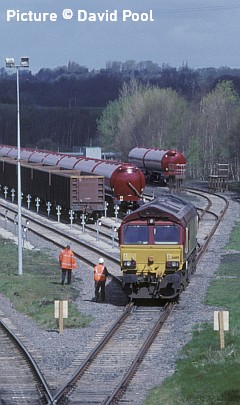
Forthcoming events
(see also our Calendar page for venues)
Note: we have removed all entries up to the end of August as the events are cancelled. The Railway Touring Company North Wales trains in July are no longer being advertised.
September 2020
Saturday 5 September Steam at Chester 'The Cheshireman' (Railway Touring Company). Norwich to Chester. Loco 6233 for part of the journey.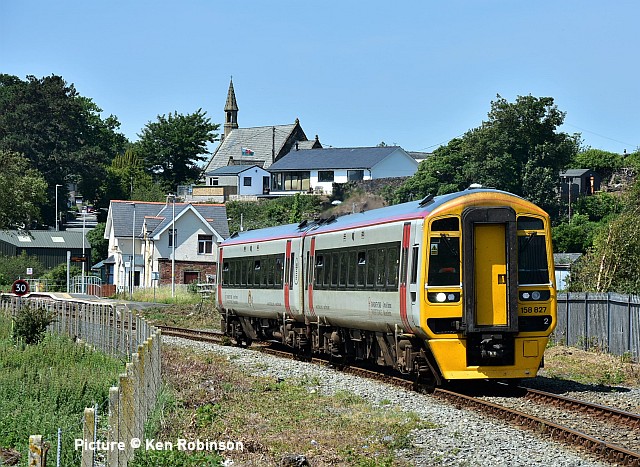
On 25 June, one of the hottest days of the year (never mind, its only 6 months till Christmas!) Ken Robinson went to just beyond Penrhyndeudraeth station, and took photographed 158 827 - with all its 'emergency' window droplights open - forming the 11:28 Pwllheli - Machynlleth. The Cambrian Coast line sees a 'Sunday timetable' (5 up and 5 down trains) for now, and this is the second of the day.
About 37 219 and ultrasonics
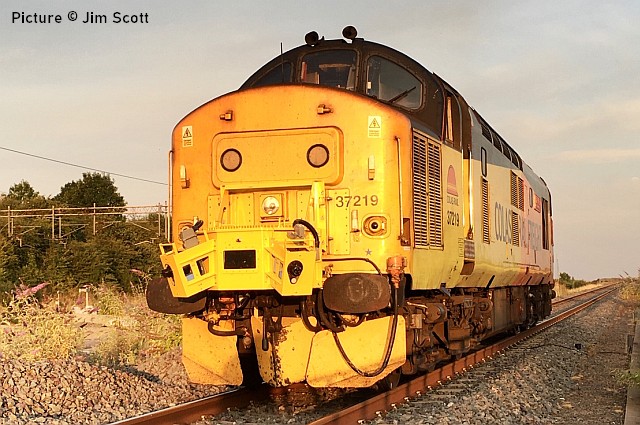
Our thanks to driver Jim Scott, who had written to answer our question about the attachments on 37 219 (last issue), and explain more about 37 219's train. The fittings on the front end are for the attachment when required of the Railway Infrastructure Alignment Acquisition System (RILA) equipment which measures clearances by laser and also videos the area around the track.
The train seen in our report includes an ultrasonic test unit (UTU), that records the track at 30mph with an ultrasound recorder which uses probes mounted in little gel-filled wheels fitted between one of the bogies on the test car, they can be raised and lowered by the operator between recording areas. Also in the formation is the SGT (structure gauging train) which shoots out lasers at speeds above 5 mph which ‘map’ to make a 3D image of the lineside to highlight any structures that may have moved since its last recording, places where there isn’t enough gauge clearance such as platform edges, bridge parapets, tunnel walls etc
The ex- Caledonian sleeper lounge car is there basically to act as a toilet as it has a catch tank.
Steam memories - by Gareth Prestidge
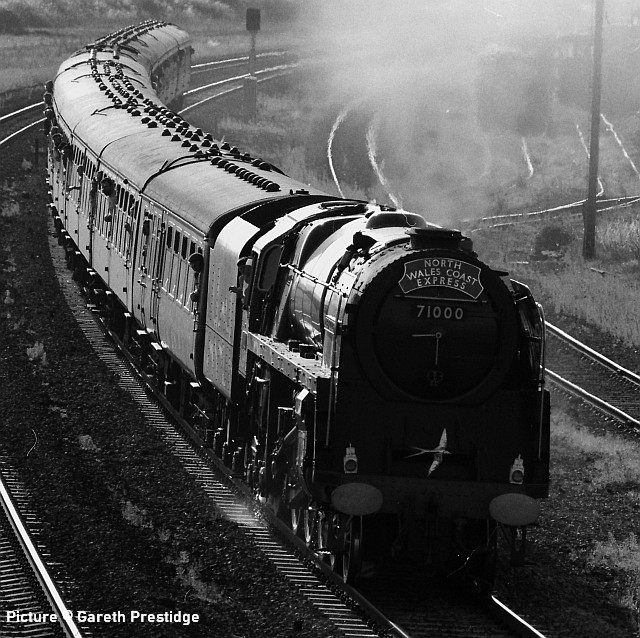
Some views from the era of regular 'North wales Coast Express' steam trains, c. 1989. Above, 71000 Duke of Gloucester passes Mold Junction sidings.
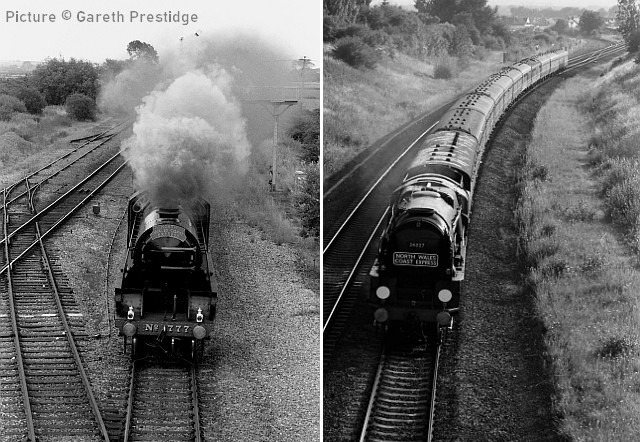
Left, 777 Sir Lamiel, not a frequent visitor, passes disconnected pointwork at Sandycroft; right, 34027 Taw Valley near Saltney Junction, with Southern-style headboard.
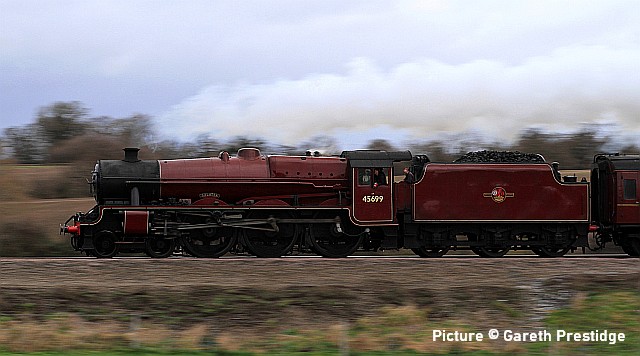
A more recent view of 45699 Galatea passing Beeston Castle in 2014.
Double-headed puzzle
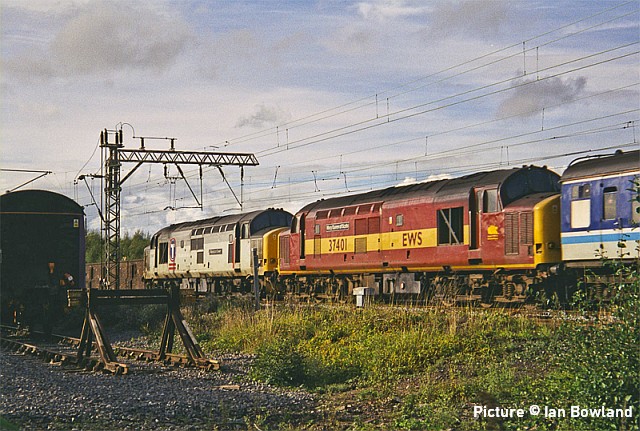
Ian Bowland writes: 'Following on from the 8 June edition and the visit onto the coast by 37 407 and 37 401, it reminded me that I had a shot of the pair passing the IEMD at
Crewe. I don't have a date for the working and have been unable to find any reference on the comprehensive Class37.co.uk web site. The shot depicts 37 407 Blackpool Tower 37 401 Mary Queen of Scots heading west out of Crewe and I wondered if anyone can provide a date and the working please? By way of an indicator I believe 407 was stored on 21 March 2000.'
Our first thought was the 15:41 (Sundays) from Crewe to Holyhead which was a double-header in 1999, although we don't have record of this combination. We think it might be Sunday 26 September 1999, based on lack of negative evidence. Comments welcome.
A 37 selection 1989/90 - by Richard Spruce
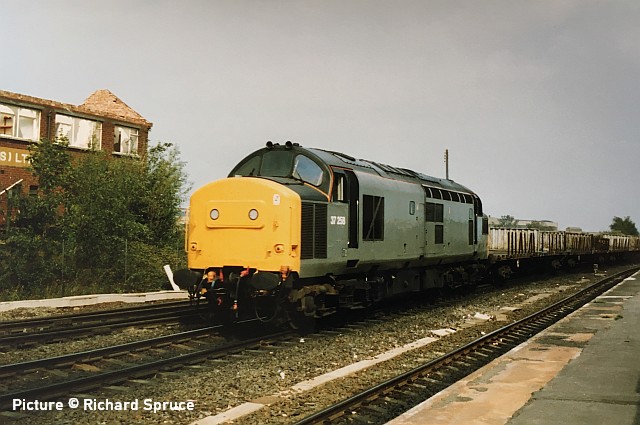
Above: 37 258 in the first version of a livery for 'departmental' locos, just plain grey. After many complaints from staff, this was modified to add a yellow area, becoming the so-called 'Dutch' livery. I believe this may have been taken at Cardiff Central but I am happy to be corrected. The loco seemed to spend much of its life in South Wales and the South West of England. It was put into storage in August 1999 and scrapped in November 2005.
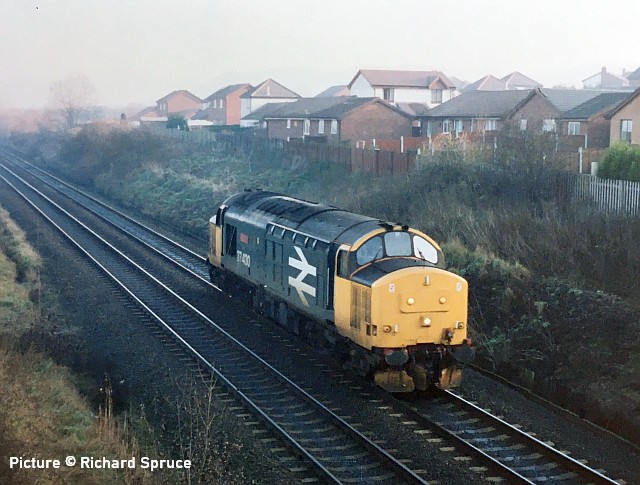
An old favourite, 37 430 'Cwmbran', runs light-engine on the approach into Helsby station, possibly on a driver training run as it had recently been transferred to the group of Immingham based petroleum locos for use out of Stanlow oil refinery, replacing the class 47s. This was only for the winter of 89/90 and it returned to passenger use the following spring. It was put in storage in March 2000 and cut up in May 2008.
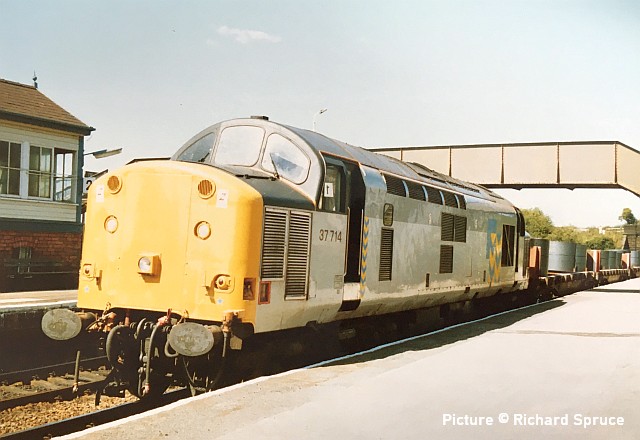
37 714 heads a Ravenscraig to Shotton steel coils service through Helsby. This loco was hired out to Spain for several years at the turn of the century and carried the number L26. It came home in 2007 and was stored for several years before returning to active service with DRS in 2012 as a shunter at Daventry freight terminal. It was then loaned out and eventually bought by the Heavy Tractor Group based at the Great Central Railway and was repainted back into Trainload Metals livery in 2017 and renamed Cardiff Canton. It was finally de-listed from Network rail in January 2020 and hopefully will remain preserved for many years to come.
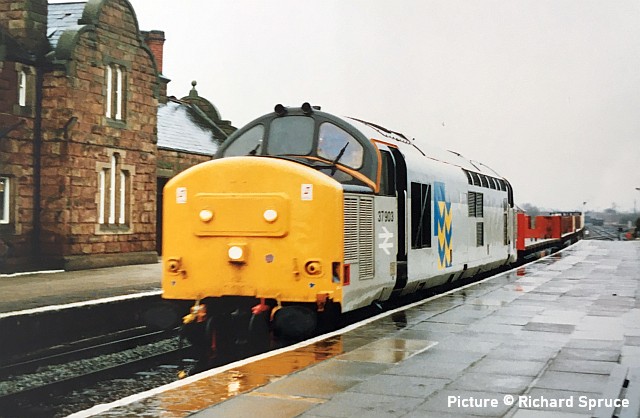
37 903, in a rather home-made version of Trainload Metals livery, takes steel coil empties from Shotton back to Ravenscraig, passing through platform 2 on a wet winter's day at Helsby.
This was one of only six 37/9s converted in 1986. Each was fitted with an alternative heavy haul power unit - the first four were fitted with a Mirrlees six-cylinder 1800 hp power unit and Brush electronic equipment and the last two with six-cylinder GEC / Ruston 1800 hp power units and GEC electronic equipment.
These power units were to be evaluated for a proposed class 37 replacement (class 38) project. As other class 37 refurbishment programmes were considered to be highly successful in reinvigorating the class, and with the arrival of privatisation, the project was abandoned. This left the sub-class class 37/9 as a small fleet of locos that were expensive to maintain due to their non-standard configuration. They were therefore withdrawn from 1997 onwards. Three of the sub-class have entered preservation: 37 901 now resides at the Mid-Hants railway 'Watercress line', having had spells at Llangollen and East Lancs railways. 37 905 is also stabled at the Mid-Hants railway. 37 906 spent several years at the Severn Valley Railway and was sold to a spot hire railway company called Europhoenix freight in 2013. In late 2019 it was moved to The Battlefield Railway at Shackerstone, Leicestershire. Sadly there was no happy ending for 37 903 which was withdrawn in December 1998 and scrapped at Crewe in October 2005.
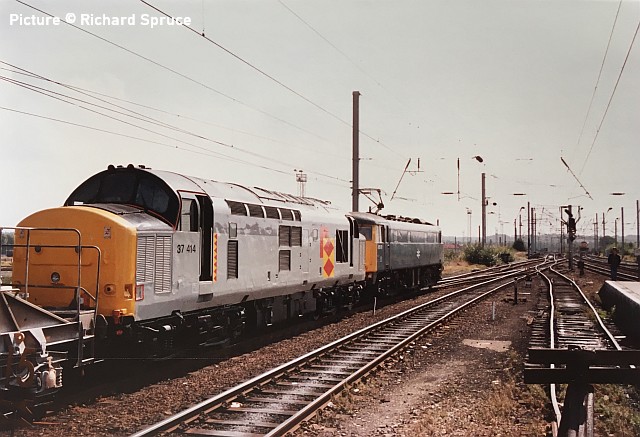
37 414 and 85 110 form an unusual combination at Warrington Bank Quay. We think this train was a 'Speedlink' freight which included 37 414 as part of its payload, on its way to Plymouth in 1989 from Glasgow works where it had been overhauled and re-painted in the 'Speedlink' (or Distribution) version of Railfreight livery livery for use in china clay traffic from Laira depot. (Note that the diamond-shaped 'depot plaque' is not yet present). The wagon behind is probably a china-clay carrier. The 85/1 sub-class were Class 85 locos restricted to freight use with a maximum speed of 80 mph.
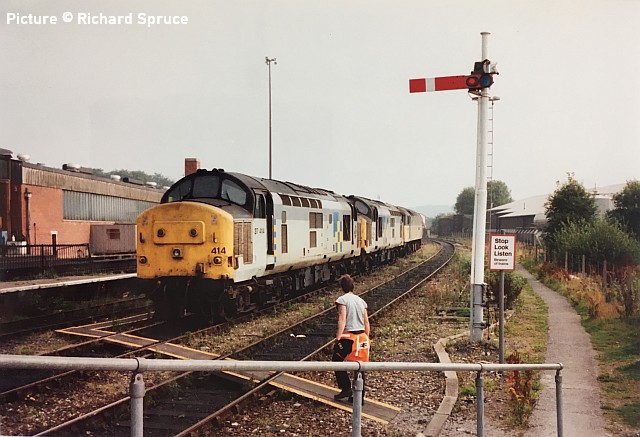
37 414 is also pictured here at Buxton with another unknown class 37 and a 47. The livery has been changed to the 'construction' version.
37 414 spent much of life (after re-building in 1985) as a dedicated passenger locomotive, being well-known in Regional Railways livery operating on the North Wales coast from 1993. These two photos capture it during its short spell as a freight locomotive.
Information on the 37/9s was mostly taken from the Llangollen Railway and Watercress Line websites. Thanks also to the Class 37 Locomotive Data Site. Here's an interesting article about the Railfreight liveries.
Holyhead scrap trains - by 'Skimpler'
In 1992 Anglesey Aluminium decided to dispose of several hundred tons of scrap steel from their site in Holyhead and however they arranged it, the steel was to go to Allied Steel and Wire in Cardiff. Five trains ran, one a week on Mondays. When I heard of this move, I went to a spot near my home in Bangor straight after work and waited it out. Freight being freight, times can vary so I was there early and waited, waited a bit more. This was 30 March and, as you can imagine in the early evening, it wasn't long before the light nose-dived. I would try a 250th of a second. Then maybe I could get away with 1/125th if I panned slightly on the front. Then I was down to a 60th and there was no point. Just as I had my hand on the door of my car, I heard it coming. No chance to get back in position but it was too dark anyway. Hopefully it would run the next week.
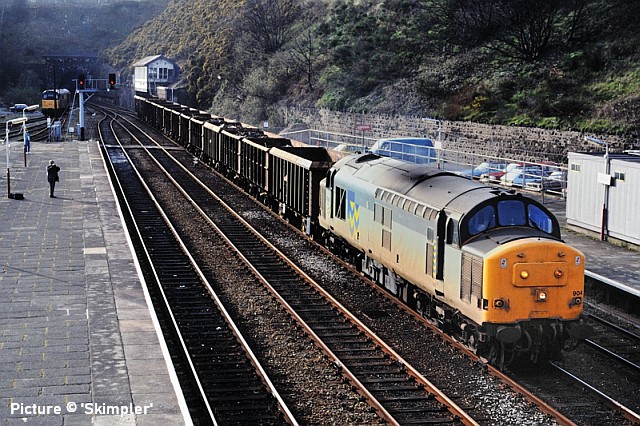
Next week, Monday 6 April, and a very nice evening in Bangor station. In those days you could do a lot of things, one of which was to open the windows on the footbridge. I managed a shot I was quite happy with and it had sun on the side too. This was made even more interesting by it being one of the six 37/9s, namely 37 904 in the correct Metals Sector markings too. This working was running as 6Z26, Holyhead RTZ sidings to Cardiff Allied Steel and Wire. The keen eyed will notice a 31 in the yard opposite the signal box.
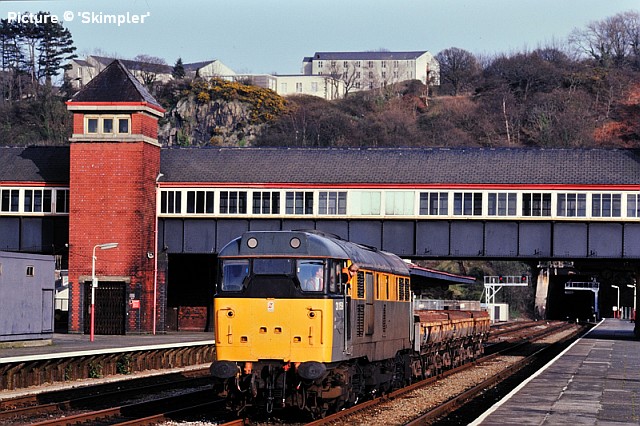
Just for interest and hopefully to fill in an extra detail, I have included a shot of it arriving earlier in the evening with three 'Turbot' engineer's wagons in tow, which it deposited in Bangor yard. Apart from anything else, a good example of how stuff could still turn up out of the blue, even then.
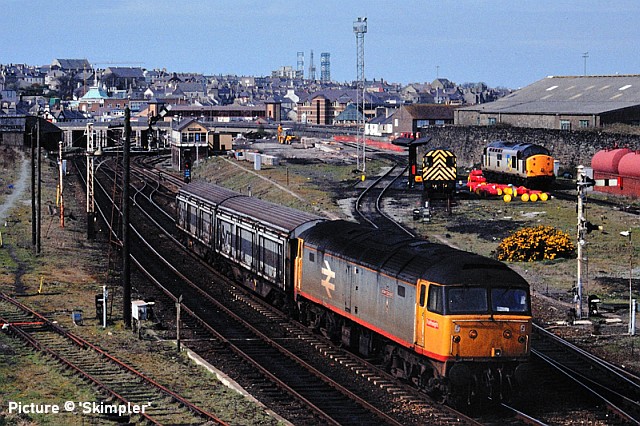
The following week, Monday, 13 April and unlucky for 37 710. I had a call from a colleague in Holyhead telling me it had worked down that morning but failed and was on Holyhead shed. I managed a half day off work and I was off to Holyhead to investigate further. Sure enough, there it was, a 37 on Holyhead depot. Not really sure how it ended up on the depot as it had taken the wagons out to RTZ sidings so must have come back under its own power. (Unless someone knows different). Anyway, I was there in time to catch the Speedlink trip which I think ran as 7T98 most days from Llandudno Junction to Holyhead. This day it was hauled by Railfreight 47 367 Kenny Cockbird which is preserved by the Stratford 47 Group on the North Norfolk Railway. Behind it is one of the Holyhead 08 shunters and Railfreight Metals Sector 37 710, apparently in disgrace but not as disgraceful as what has just happened to Holyhead shed. This shows the base of the new "shed" which was to be erected in its place.
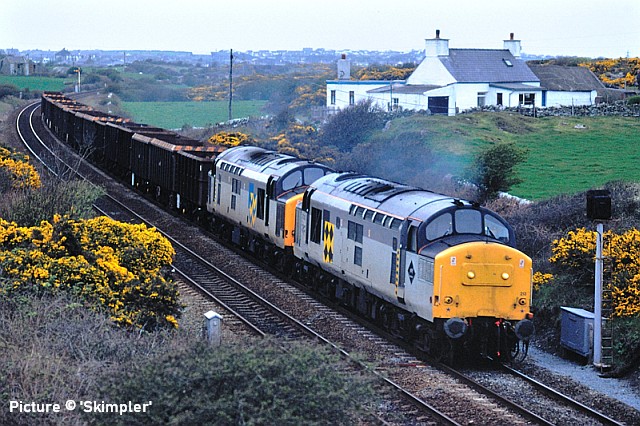
Railfreight Coal Sector 37 213 arrived from "upthe line", probably Crewe but I don't know that for sure, to collect 37710. Not taking any chance on what time it would leave with the train from RTZ, I waited it out on a bridge near Caergeiliog. It was a good thing I was that side of the Island too as it was very late leaving. This shot of the two engines was taken at 19:10 and it was through Bangor by that time the previous week. Apart from the train obviously, something else of interest here is that, just about, there are two distant signals in this shot. In the distance is Valley down distant, still semaphore then and right by the engines is 'RAF Valley emergency up distant', probably not its correct title. There are signals both ways each side of RAF Valley which only show an indication in case of emergency or a fault.
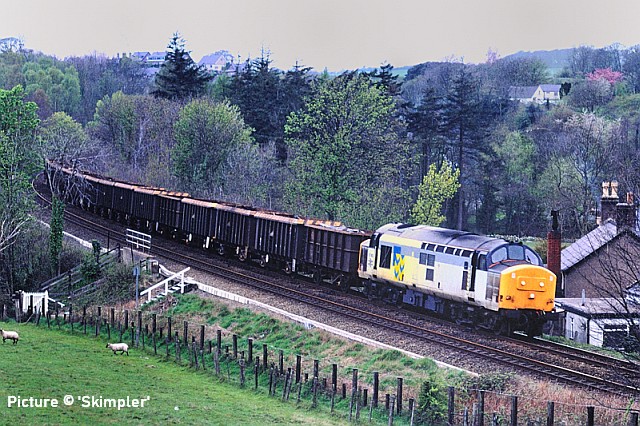
The following week, Monday 20 April and I caught the train again on Tal-y Bont curve, struggling for light again, this time it was hauled by Railfreight Metals Sector 37 903, another satisfying catch. The sheep seem to have turned their backs on it, probably because it is a South Wales engine. Not related to Railways by right by the nose of the engine is a tall, red-brick chimney. On Thursday 19 July 1984, North Wales was rocked by an earthquake of magnitude 5.4, the strongest recorded in the UK. That red brick chimney collapsed. There were many reports of damage in the press but that is the only damage I knew of locally.
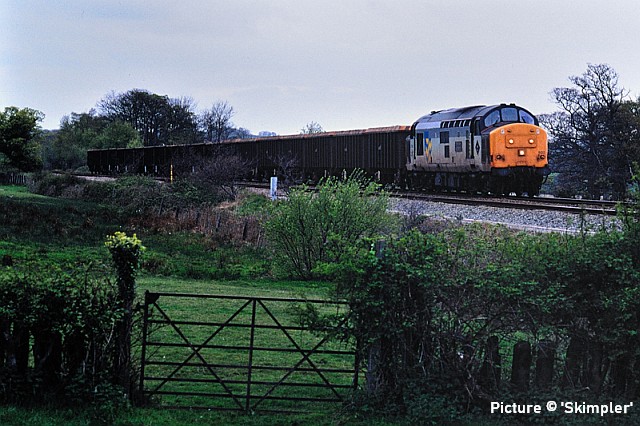
The last working was on 27 April, another dull evening and nearly being May I could have expected better. I caught this at Tai'r Meibion farm crossing between Aber and Bangor. There used to be a signal box called Tai'r Meibion but I don't know its exact location on the line. It was one of three between Aber and Bangor, the other two being Penrhyn Sidings and Bethesda Junction. This time the train was hauled by another 37/9, Railfreight Metals sector 37 902.
Looking back: Northwich area - with David Pool
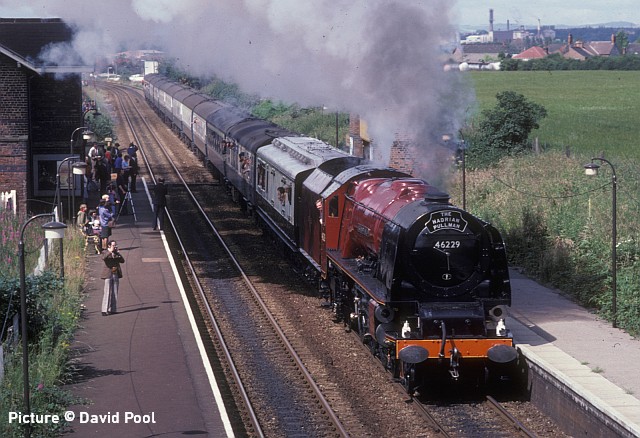
46229 Duchess of Hamilton is passing through Lostock Gralam station on 18 July 1981 with “The Hadrian Pullman”, heading for Leeds, York, Newcastle and Carlisle. The train had started from Northwich, running as 1Z68, which accounts for the interest shown by local residents. Deltic 55 014 took over at York for the run to Carlisle. Details of this particular Railtour have not been documented as fully as might have been expected, and I have no information on the return route or motive power.
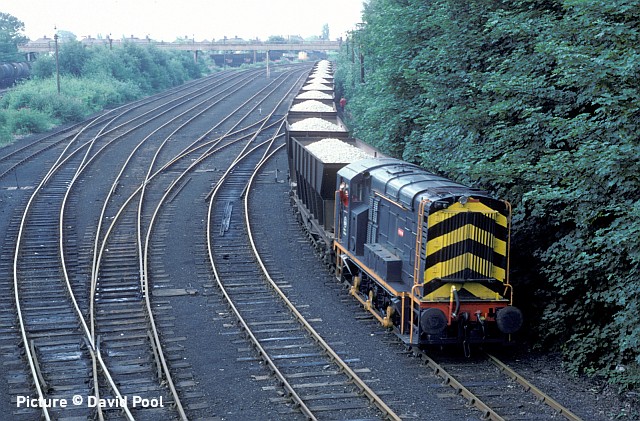
The limestone hoppers from Tunstead would arrive at Oakleigh sidings, where the British Rail diesels would be replaced by an ICI locomotive for the movement into Winnington Works. Perkin was built by English Electric in 1951 (Works number 1904), and was one of a small fleet of 0-6-0 diesel electric locomotives, not unlike a British Rail class 08, photographed from Winnington Lane on 30 May 1982.
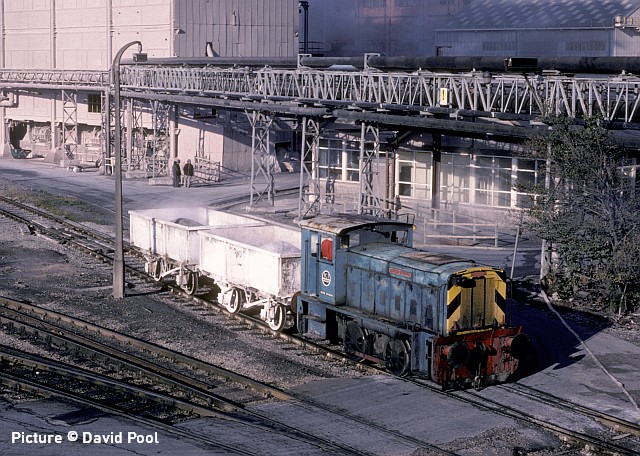
In addition to the English Electric locomotives, ICI had a similar number of Ruston Hornsby 0-4-0 locomotives, which were used on lighter duties. F A Freeth is in Wallerscote Works on 30 September 1982, having been built in 1957, R-H Works number 416213., and used at ICI’s Middlewich Works until the rail system there closed in 1962.
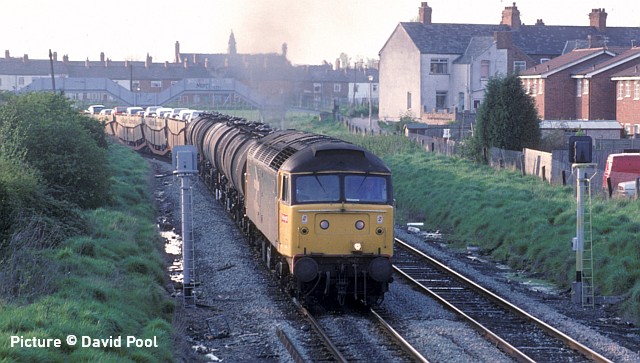
The triangle at Northwich offers many photographic opportunities from the footbridges which cross the lines. On 3 May 1989 47 014 is heading for Middlewich and Crewe, having come from Warrington via the Hartford curve with a Speedlink service comprising tank wagons and car carriers.
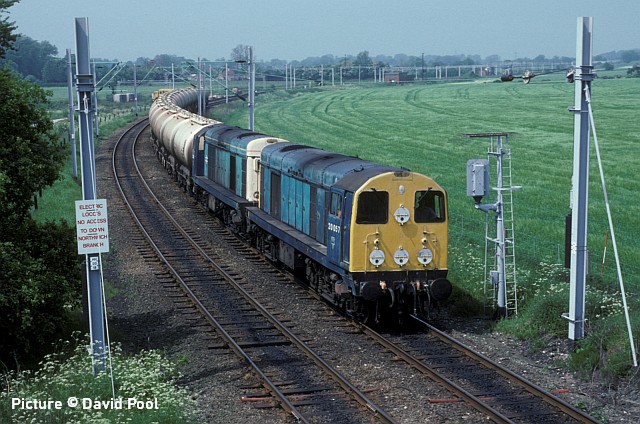
On 23 May 1992 I had been photographing at Winwick Junction, and saw two Class 20s on the trip working from Hays Chemicals in St. Helens to Warrington Arpley. I moved on to Hartford, where the line to Northwich branches off the West Coast main line, and was somewhat surprised to see the same two 20s approaching with the Soda Ash wagons from Larbert in Scotland, heading for Oakleigh. Since this train was usually hauled by an electric Locomotive (often a Class 85) as far as Warrington, 20 057 and 20 154 must have come on there.
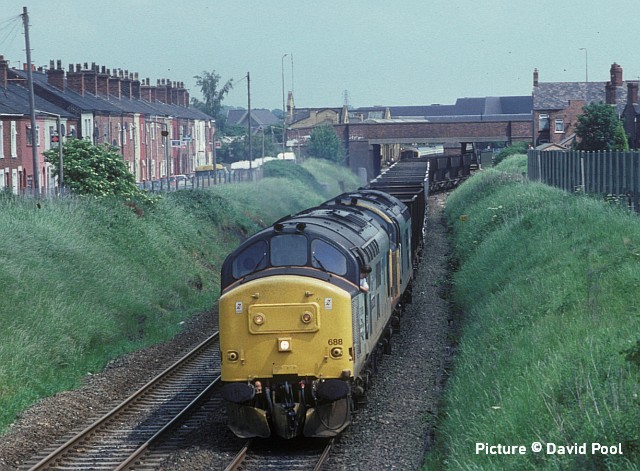
There were diversions on 31 May 1992, when the Tunstead to Oakleigh trains did not take the usual route through Stockport to Northwich, and ran instead via Warrington, Acton Bridge and Hartford. I had photographed 37 688 and 37 685 at Hartford and after arrival at Oakleigh, and I cannot recall whether I then got details of the return empty working, but it appears that the 37s did not leave Oakleigh by Hartford West Junction, but by Hartford East, in the direction of Northwich, where the locomotives ran round. The photograph shows the 37s heading back towards Greenbank station and the West Coast main line.
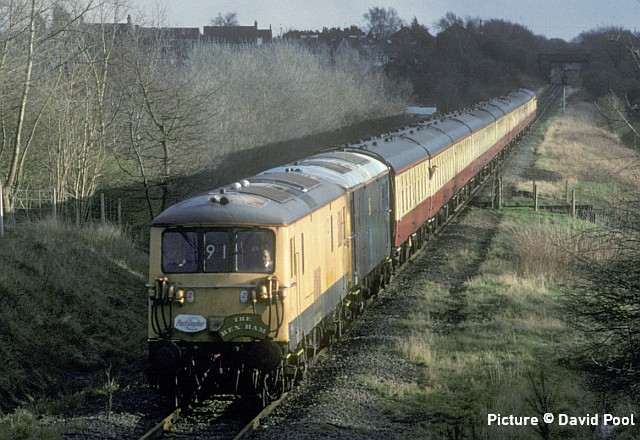
The Merseyrail Class 73s had a rare outing on 28 February 1998, working the Crewe to Chester leg of “The Rex Ham” Pathfinder Railtour from Reading. .The Railtour Files website gives details of the problems encountered by locomotive difficulties and last minute route changes, which led to the arrival at Crewe about one hour late. The Middlewich branch has severe speed restrictions, and I was despairing of the Railtour arriving in daylight, but somehow there was still some sunlight at 1620 when 73 906 and 73 005 passed me near Northwich South Junction, having made good time from Sandbach.
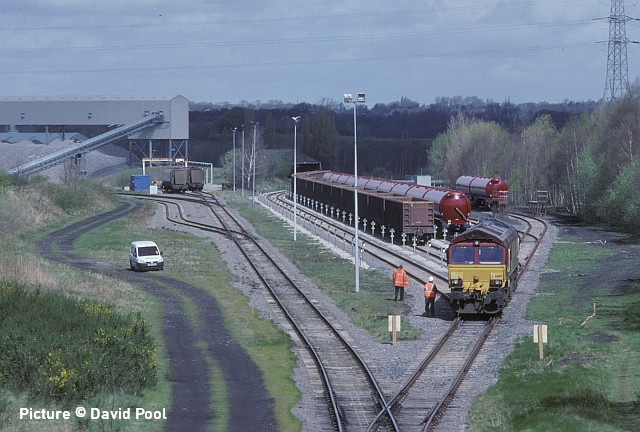
My photograph taken on 12 April 2005 shows Winnington sidings, beyond the Oakleigh sidings, where 66 180 was marshalling a train of CTA bogie tanker wagons containing brine. The MBA wagons on the left were used for conveying Pulverised Fuel Ash from Drax. A plant at Winnington combined the PFA with cement and other ingredients to produce a grout mix, which was then piped and injected into disused salt mines in Northwich to stabilise them and prevent subsidence. Brine displaced by the grout was pumped back to Winnington, where it was sent by rail to the British Salt works at Middlewich. The project started in 2005 and was expected to last for two years.
Cambrian corner 2004 - images by Ben Bucki
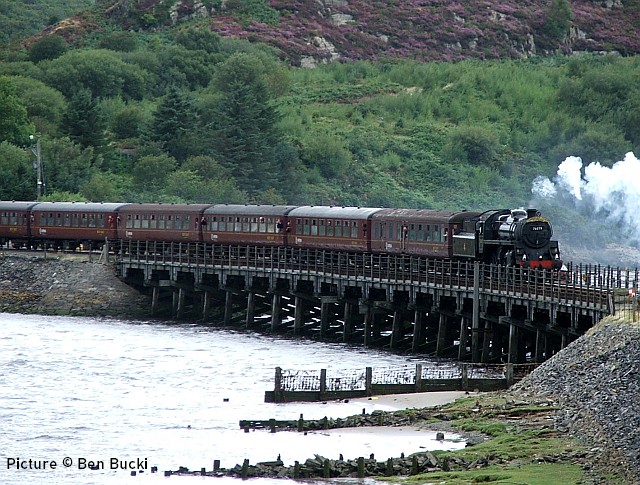
Summer 2004: in the days before the ERTMS signalling eradicated steam specials on the Cambrian lines, 76 079 brings the 'Cambrian Coast Express' across the old Pont Briwet ...
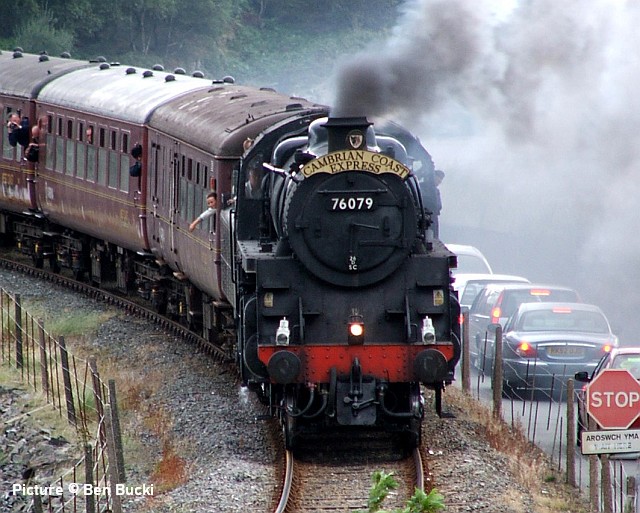
... as cars queue to pay the toll levied on the road side of the bridge. A new (Toll-free) structure has since replaced the Cambrian's wooden version.
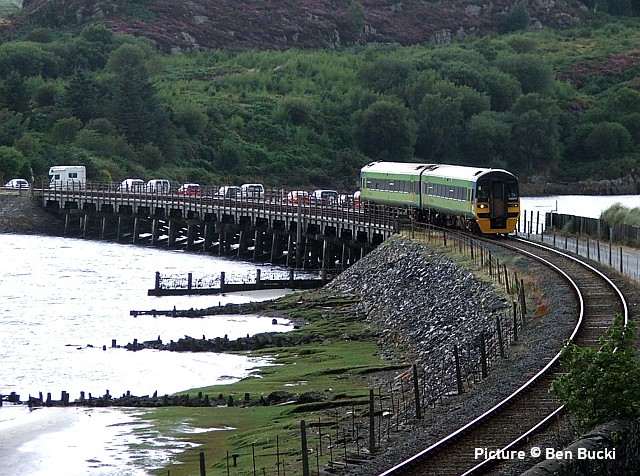
Arriva had taken over the running of the line in the previous autumn, but this had yet to be reflected in the liveries of some of the Class 158 units such as this one which still sports the green of Central Trains, which had ceased to run this line in 2001 when it was transferred to the 'Wales and West' franchise.
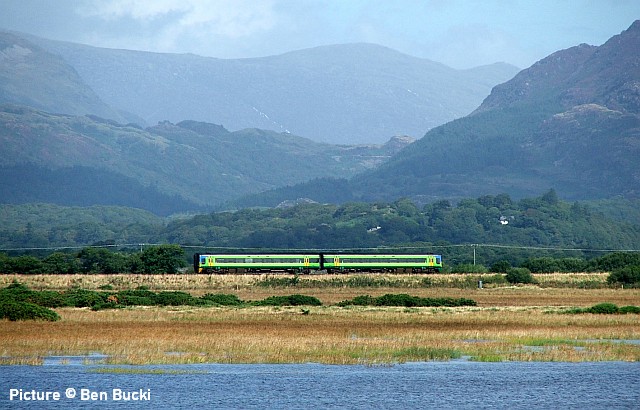
Another green unit near Porthmadog.
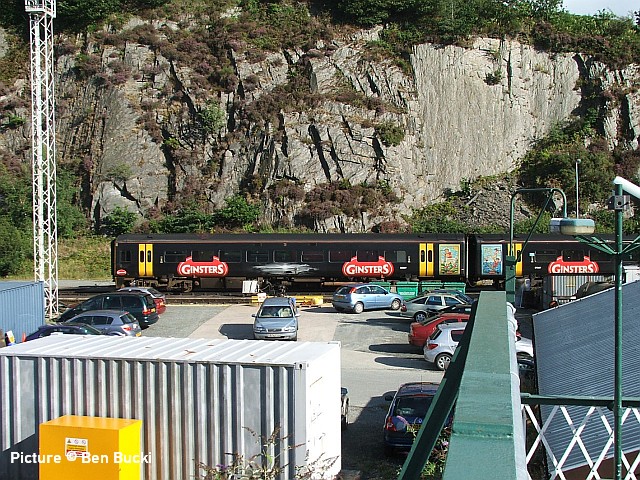
Wales and West had turned some of their units into adverts for Ginster's manufacturers of pies, pasties and sandwiches, as seen here at Machynlleth depot.
North Wales Coast home page | Archive | Previous Notice Board